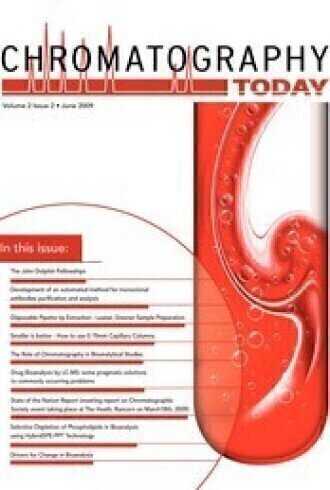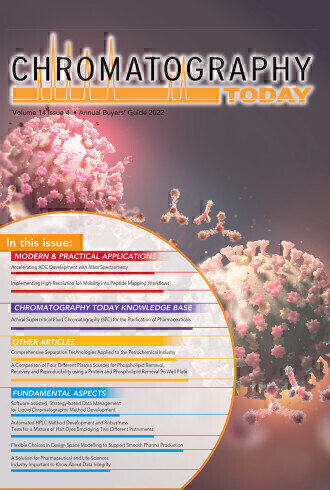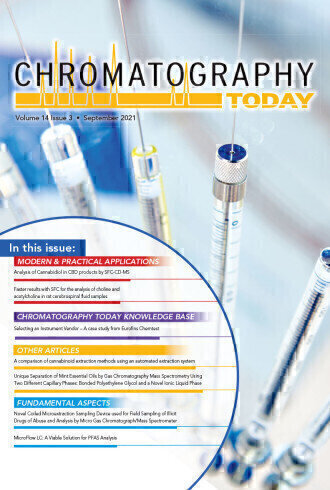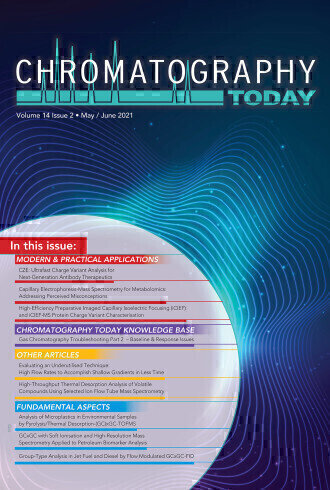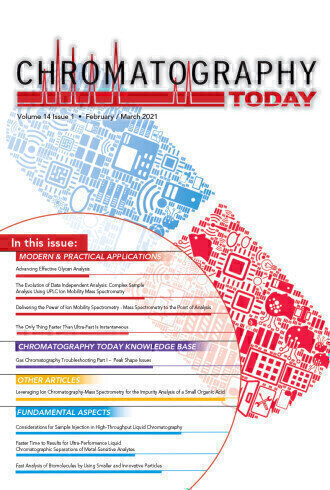Volume 2 Issue 2
Welcome to the sixth edition of Chromatography Today, the principle theme of which is Bioanalysis. Bioanalysis, or the analysis of analytes in biological matrix, has been largely dominated by pharmaceutical analysis over the last 30 years. With the potential rewards of billion dollar blockbuster drugs, investment in analytical technology by pharma companies has fuelled the rapid development of this field of analytical science. In the late 80s and early 90s, the development of atmospheric pressure chemical ionisation (APCI) and electrospray ionisation (ESI) sources for mass spectrometers lead to the domination of mass spectrometers as detectors for HPLC in this field and this is still true today. However, there has been an interesting journey over the intervening years in the application of chromatographic techniques associated with the hyphenated technique of liquid chromatography-mass spectrometry (LC-MS).
With the explosion of triple quadrupole mass spectrometry (LC-MS/MS) methodologies in the mid 90s, there was a tendency to assume the selectivity of the mass spectrometer would obviate the need for good
chromatography. Short 3-cm columns were used to retain analytes long enough to remove the ion suppression effects associated with the salts in the sample extracts but no longer than necessary to hinder sample
throughput. However, very soon there was a realisation that thermally unstable metabolites, such as N-oxides, had the potential to interfere, requiring at least some moderate amount of retention to ensure resolution. This lead to the application of fast or even ballistic gradients where samples were injected in a highly aqueous mobile phase to promote retention but then subject to rapidly changing mobile phase conditions such that organic content would reach 90 or 95% over a matter of 1 or 2 minutes. This allowed assays to be developed for both polar metabolites and less polar drug analyte, with very sharp peaks, in a relatively short run time. These “slap it on – blast it off” techniques hardly promoted good chromatographic technique, and a whole generation of bioanalysts grew up with no real appreciation for such things as van Deemter equations.
However, all this has changed in the last few years with the advent of the sub 2-μM particle columns. This has sent your average bioanalyst scurrying off to dust off their chromatography books so they can cite the resolution equation when asked or even as far as discussing Kinetic Plots over coffee. Good chromatographic technique is here to stay in bioanalysis, and with a better appreciation for the need to minimise matrix effects and the regulatory requirement for demonstrating such things as “incurred sample reproducibility”, potential gains of greater efficiency and speed from small and fused core particle columns or monoliths must be realised.
The articles in this issue cover a range of topics associated with bioanalysis from the practicalities of sample preparation techniques to future gazing where this field of analytical science may be heading. Interestingly, even in meetings organised by the Chromatographic Society (November, 2008; Ware) there is increasingly some confusion between bioanalysis as defined above and the analysis of biomacromolecules. Indeed, the latter even finds itself in this issue! However, in this ‘future gazing’ article by Howard Hill the distinction is clearly drawn between the two and the future of bioanalysis of biomacromolecules is considered. We hope you find them interesting and we are always happy to receive feedback. Finally, on the theme of bioanalysis, it is worth mentioning that the 18th International Reid Bioanalytical Forum, a Chromatographic Society event, is being held
this year at the University of Surrey, Guildford, UK from 6-9 July 2009. Full details may be seen on www.chromsoc.com. On Chromatographic Society matters, this issue also contains an announcement of John Dolphin Fellowships and a report of our meeting “Separation Science in the UK: State of the Nation”. The former will help us to do something about the latter. However, the meeting was not intended as a one-off review. The intention is that developing separation science, especially in the UK, will continue to take a very high priority for the Society and we are very keen to hear the views of the Chromatography Today readership on what we should be doing on this matter. Please contact us through chromsoc@meetingmakers.co.uk. We look forward to hearing from you.
Previous Digital Editions
Digital Edition
Chromatography Today - Buyers' Guide 2022
October 2023
In This Edition Modern & Practical Applications - Accelerating ADC Development with Mass Spectrometry - Implementing High-Resolution Ion Mobility into Peptide Mapping Workflows Chromatogr...
View all digital editions
Events
Apr 28 2024 Montreal, Quebec, Canada
May 05 2024 Seville, Spain
May 15 2024 Birmingham, UK
May 19 2024 Brno, Czech Republic
May 21 2024 Lagos, Nigeria
